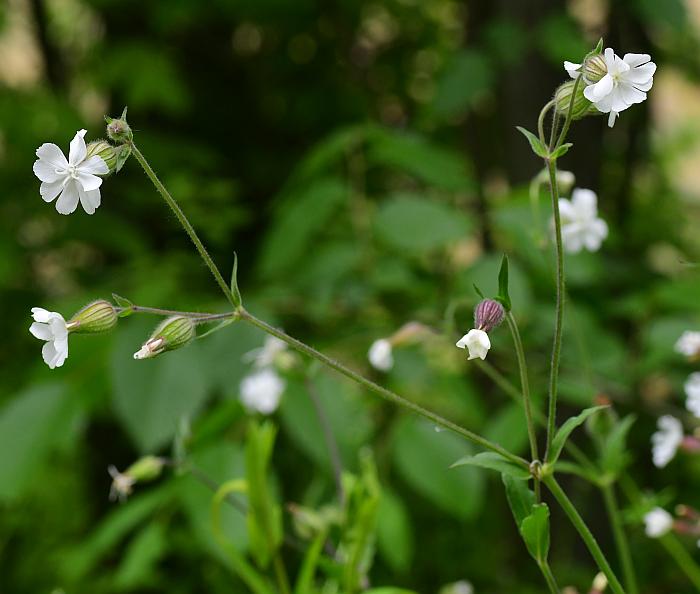Silene latifolia Poir.
White Campion

Introduced
CC = *
CW = 5
MOC = 31
© SRTurner
Silene latifolia Poir.White Campion | |
 |
Introduced CC = * CW = 5 MOC = 31 |
© SRTurner |
|
Family - Caryophyllaceae Habit - Annual or short-lived perennials forb, dioecious, with a sometimes woody taproot. Stems - Ascending to erect, to 1.0 m, sometimes from a spreading base, branched, pubescent with stalked glands and also roughened with short, stiff, downward-angled hairs toward the base.
Leaves - Basal and opposite, entire. Basal leaves usually withered at flowering, when present shorter than to about as long as the largest stem leaves, mostly long-petiolate, spatulate. Stem leaves opposite, usually 6-12 pairs, sessile. Leaf blades 3-12 cm long, elliptic to lanceolate, tapered at the base, angled or short-tapered to a sharply pointed tip, the surfaces finely pubescent with sometimes somewhat tangled, nonglandular hairs. At least the upper leaves connected at base by a thin membranous sheath.
Inflorescence - One to many flowers in an open dichasium. Pedicels 0.5-4.0 cm long, those of the pistillate flowers usually longer than those of the staminate flowers, with stalked glands, the bracts paired and resembling small leaves, with green margins. Flowers opening at night, fragrant. Flowers - Imperfect, staminate or pistillate. Sepals 10-20 mm long, in pistillate flowers becoming enlarged to 30 mm at fruiting, the tube with 10 (staminate flowers) or 20 (pistillate flowers) parallel nerves, with a network of sparse to moderate, anastomosing, angled crossnerves, tubular to slightly conical and not inflated at flowering, in pistillate flowers becoming ovoid and inflated as the fruit matures, the nerves green to reddish-tinged, pale to nearly translucent between the nerves, pubescent with a mixture of nonglandular hairs and stalked glands, the lobes ovate to narrowly triangular, green to purplish, angled or short-tapered to a sharply pointed tip, the margins green. Petals 5, 24-32 mm long, the expanded portion 8-12 mm long, entire to deeply cleft, white, with a pair of small appendages on the upper surface at the base of the expanded portion. Stamens 10, typically included. Styles 5, variably exserted, white, glandular-pubescent, ribbonlike in apical 1/2. Ovary green, 7 mm long, 3 mm in diameter, cylindrical, glabrous.
Fruits - Capsules 11-18 mm long, dehiscing apically by 10 teeth, with a stalklike base 0.8-1.5 mm long. Seeds 1.0-1.3 mm wide, kidney-shaped and plump, the surface coarsely tuberculate, dark grayish brown to dark grayish black.
Flowering - May - September. Habitat - Pastures, fields, old homesites, railroads, roadsides, open disturbed areas. Origin - Native to Europe. Lookalikes - S. noctiflora (which is rare in Missouri). Other info. - This little plant occurs across Missouri, though it is scattered and somewhat uncommon. It is also found across the continental U.S. except in a few far southern states. It is a distinctive plant, with showy white flowers and inflated, barrel-shaped calyces. Male (staminate) and female (pistillate) flowers are found on different plants. The images above clearly illustrate the two types of flower. The lookalike Silene noctiflora appears very similar, and also blooms at night, but has perfect flowers. The dehiscing capsules of that species also have 6 teeth rather than 10, and its flowers have 3 styles rather than the 5 styles found in the pistillate flowers of S. latifolia. Photographs taken at Geneva State Park, Geneva, Ohio, 8-7-00, and at Pictured Rocks National Seashore, MI., 7-23-02 (DETenaglia); also near St. Albans, Franklin County, MO, 10-15-2011, near Labadie, Franklin County, MO, 4-8-2012, along the Katy Trail near Dutzow, Warren County, MO, 8-1-2012, 5-22-2020, and 6-6-2020, and near Loda Lake, Newaygo County, MI, 8-27-2020 (SRTurner). |